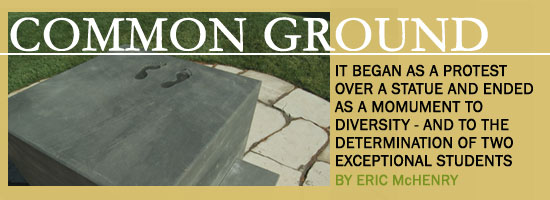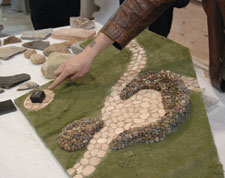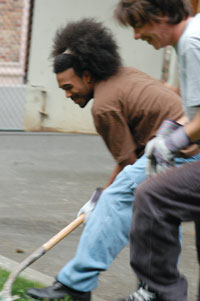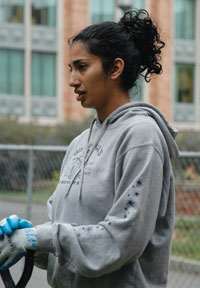

Gardner first began paying close attention to public art on campus in the fall of 2003, when the University announced that a statue of former football coach Jim Owens would be dedicated outside Husky Stadium. Owens, who came to the UW in 1957 and retired in 1974, was straight out of central casting—a hard-nosed Southerner who transformed a team with no winning tradition into a perennial Rose Bowl contender.

But his legacy has long been tarnished by allegations of racism: that he “stacked” black players at certain positions to limit their time on the field, that he punished them excessively, that he admonished them not to date white women. Owens, who is now in his late 70s, denies all of these charges, although he has expressed some regrets. The week of his statue’s unveiling, he met with former players in an attempt to reconcile, and told the media that he wished “we had done some things different”—gestures that satisfied some of his critics and struck others as half-hearted.
The statue was commissioned by Owens’ friends and former players (including one African American), and donated to the UW. What troubled Gardner and Das Gupta was the lack of discussion within the University community. One more bronze likeness of one more white man with an uneven record on race had simply materialized on campus. They and some friends decided to “flier” that year’s Apple Cup game—putting the case against Owens down on paper and passing it out to Husky fans. But Owens remains a popular figure. Not surprisingly, some of those fliers came flying right back in their faces.
Gardner and Das Gupta—well-known around campus as “J.B. and Sumona”—had a history of student activism. But this experience got them thinking for the first time about visual art as a vehicle for political messages. “The biggest thing we got from Jim Owens,” says Das Gupta, “was the idea that you can use art in powerful ways.” They agreed to refocus their efforts on a diversity monument, and began drawing up lists of deans and department heads, sending e-mails, making phone calls and knocking on doors.

Their initial inquiries met with plenty of encouragement, but after several months of meetings, Gardner and Das Gupta found that they were no closer to having a commitment from the University than they’d been at the start. “We completely got the runaround,” Das Gupta says. “Part of it was the fact that our idea was very innovative, so no one had a clue as to how to go about it. It wasn’t exactly like we were being discouraged —‘We don’t want you to go through with it.’ It was more like, ‘We want you to go through with it, but call me later.’ Or, ‘Find somebody to help you, and if you need anything, come back.’ No one would really step up and say, here, let me get you through the door.”
Finally, they found their way to Connie Kravas, vice president for development and alumni relations, who was impressed by their sincerity and determination. “They told me how many offices they had been to,” says Kravas. “So many places. And I’m thinking, ‘Oh my gosh. These kids are just giving their hearts and souls to this.’ But I never saw a twinge of anger or frustration from them.”
Kravas realized the students were in a bind—they would have trouble getting funding until they had a proposal, and trouble drawing up a proposal until they had some idea of where their money was going to come from. Taking their persistence as proof of their intent, she told them what they needed to be told: the buck starts here. She made a commitment to fund the inchoate project out of her department’s budget, and her staff subsequently rounded up contributions from nearly a dozen other UW units—including the president’s office, and intercollegiate athletics.
She also steered the students to a number of administrators who could help them bring the project into sharper relief. “All of us knew that this project would be a failure if it were forwarded as a reaction to the Jim Owens statue,” says Debra Friedman, a former director of special projects for development and alumni relations, who was recently named dean of the College of Public Programs at Arizona State University. “The project had to be freed from its roots. And the students understood that very quickly.”

“J.B. and Sumona talked about the campus not feeling comfortable and welcoming to students of color,” says Kurt Kiefer, the campus art administrator. “So one question we asked was, is this about image-making—about the fact that there aren’t images of significant people of color on campus? Or is it about place-making? Is it that there aren’t places that are comfortable?” The administrators, in turn, steered the students to John Young, a professor of sculpture and public art. For several years, Young has been teaching a design-build course that culminates in the creation of a piece of public art. Its past projects are all over the city, including “Give Voice,” a sunken space in the Campus Parkway median featuring steel megaphones, benches and an overturned table. Gardner asked Young to consider devoting the class to a diversity monument.
“And I said to him, ‘You need to do the following things,’ ” Young recalls. “ ‘You need to come up with a budget, a minimum of $30,000, and you need to come up with a site on campus that they’re willing to allocate to this.’ Every design-build has those two requirements. And so we had a very pleasant conversation, and I hung up, and I thought that would be the last I would hear from him.”
Young didn’t realize how many aces Gardner was already holding.
“Lo and behold, this kid comes up not with $30,000 but with $50,000 from UW development, and with two sites to consider on campus. When he did that, I had to take this course on.”
Go To: Page 1 | Page 2 | Page 3